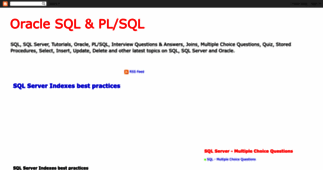Oracle SQL & PL/SQL
Enter a key term, phrase, name or location to get a selection of only relevant news from all RSS channels.
Enter a domain's or RSS channel's URL to read their news in a convenient way and get a complete analytics on this RSS feed.
Unfortunately Oracle SQL & PL/SQL has no news yet.
But you may check out related channels listed below.
Related channels
-
Oracle ERP Functional and Technical Guide
Oracle ERP Functioncal and Technical Materials is about to share my knowledge on Oracle Apps R12,ERP,Apps Functional and...
-
Database Recovery Software | Database Diasaster Recovery Solutions
Database recovery for SQL, MySQL, Oracle, Access, SharePoint & FileMaker
-
SQL Teachers
Sql teachers is about sharing my experience in sql server, transact sql, oracle, hadoop, big data.

